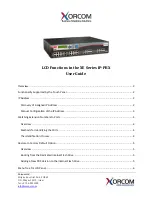
1.1 Incoming Call Features
24
Feature Guide
b)
When the call was intercepted via Intercept Routing—Busy and arrived through a public line, the
call waits at the original destination. If the extension has Call Waiting activated, the user will hear
a call waiting tone. When the call arrived through a private line, the caller hears a busy tone.
c)
When the call was intercepted via Intercept Routing—DND and arrived through a public line, the
call waits at the original destination and it rings. When the call arrived through a private line, the
caller hears a busy tone.
•
If the intercept destination can, but does not, answer the call:
The call continues to ring at the intercept destination until answered.
•
Intercept Routing—Busy/DND on/off
Intercept Routing—Busy and Intercept Routing—DND can each be enabled or disabled for the entire
system, through system programming. If enabled, calls will be routed to the appropriate destination.
If disabled, a call to an extension which is busy or in DND mode will be handled as described below,
depending on the type of CO line carrying the call.
a)
Public Line: The caller will hear a ringback tone. If busy, the extension will not ring. If in DND mode,
the extension will ring.
b)
Private Line: The caller will hear a busy tone.
•
Idle Extension Hunting
If an extension is a member of an idle extension hunting group, calls to that extension will not be
redirected by Intercept Routing—Busy/DND. If the extension is busy or in DND mode, calls to that
extension will be redirected to the next extension in the idle extension hunting group.
Feature Guide References
1.3.1 Call Forwarding (FWD)/Do Not Disturb (DND)
1.1.1.5
Intercept Routing—No Destination
Description
Directs a CO line call to an operator when the call has no assigned destination.
Conditions
•
Intercept Routing—No Destination on/off
Intercept Routing—No Destination can be enabled or disabled for the entire system, through system
programming. If disabled, the caller will hear a reorder tone.
Note that this feature can only be disabled for calls which arrived on a private CO line; Intercept
Routing—No Destination always functions for public CO line calls.
•
If an operator is not assigned:
The default intercept destination will be the extension connected to the lowest numbered port, on the
card installed in the lowest numbered slot.
•
Intercept Routing—No Destination also applies to calls from doorphones.
Feature Guide References
Summary of Contents for KX-TDA50
Page 16: ...16 Feature Guide...
Page 17: ...Feature Guide 17 Section 1 Call Handling Features...
Page 67: ...1 5 Making Call Features Feature Guide 67 User Manual References 1 2 1 Basic Calling...
Page 215: ...Feature Guide 215 Section 2 System Configuration and Administration Features...
Page 244: ...2 4 Fault Recovery Diagnostics 244 Feature Guide...
Page 245: ...Feature Guide 245 Section 3 Programming Instructions...
Page 281: ...Feature Guide 281 Section 4 KX TDA50 Maintenance Console Operating Instructions...
Page 446: ...4 8 System 2 446 Feature Guide Feature Guide References 1 16 1 Caller ID...
Page 621: ...4 14 ARS 8 Feature Guide 621 Feature Guide References 1 9 1 Automatic Route Selection ARS...
Page 652: ...4 17 Maintenance 11 652 Feature Guide...
Page 653: ...Feature Guide 653 Section 5 Appendix...
Page 661: ...Feature Guide 661 Index...
Page 667: ...Index Feature Guide 667...




































